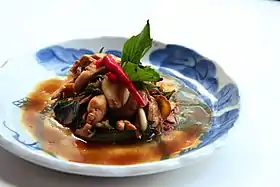Sanbeiji
Sanbeiji (simplified Chinese: 三杯鸡; traditional Chinese: 三杯雞; pinyin: sānbēijī; Wade–Giles: San1-pei1 chi1; Pe̍h-ōe-jī: sam-poe-ke; lit. 'three-cup chicken') is a popular chicken dish in Chinese cuisine and one of the most iconic dishes of Jiangxi cuisine and Taiwanese cuisine,especially popular in Taiwan . There is a specialty of Ningdu. It is also served as a postpartum confinement food by the Chinese community of Malaysia.[1] The Jiangxi style is spicy, while Taiwanese style is non-spicy. Taiwanese put Thai basil in the dish.There are more difference(ingredients) between Jiangxi style and Taiwanese style.[2][3][4]

Origins
There are several versions for the origins of sanbeiji. These stories often involve a cook who placed three cups of sauces into an earthenware pot and simmered it for a long time. One version is that of Wen Tianxiang, a national hero and Jiangxi native during the Song dynasty. Wen was captured by the invading Yuan armies of Kublai Khan and tortured for four years during his imprisonment. It was during this time that a sympathetic prison warden cooked the dish for him (using these limited resources) before Wen Tianxiang's execution. However, a paper examines Jiangxi local gazetteers and cookbooks from both Ming-Qing and Republican eras.While there are no records of the term ‘Three-Cup Chicken’ in these sources,there were many dishes that were similar to Three-Cup Chicken.[2]
On the other hand, native Taiwanese local senior chefs and restaurant owners believe that Three-Cup Chicken originated in Taiwan. They believe that this dish was developed to serve two purposes: 1) to reduce the amount of rice wine for women to eat after childbirth; and 2) to increase the length of the period during which it would remain edible, which derives from the concept of frugality. In addition, Taiwanese farmers cooked Three-Cup Chicken using sesame oil, rice wine,and soy sauce, and after 1970s, this combination of seasoning for this dish was promoted as ‘native chicken village’.[2]
"Three cups"
The dish derives its name from the three cups of sauces required. For each chicken, a cup each of soy sauce, rice wine (usually mijiu although it may be mixed with Shaoxing jiu), and sesame oil are added in Taiwanese style.[5] The traditional recipe in Taiwan called for a cup each of rice wine, soy sauce, and sesame oil, with added ginger, garlic, and Thai basil.[3] Thai basil has been added to the dish since 1980s around Taiwan.[2]
Each cup of Jiangxi style is soy sauce, Jiuniang and lard,and there is no basil added.[2][4]
The chicken, together with the sauces, is cooked in an earthenware pot on high heat for ten minutes, then on low heat to allow the sauces to be absorbed by the meat. Sanbeiji is served with no sauce; the dish is cooked until all the sauce evaporates and is absorbed by the chicken. When it is served at the table, the chicken should be sizzling—even popping—on the cusp of burning. This gives the chicken a crisper texture (and richer flavor) unlike most other Chinese or Taiwanese stewed dishes. The dish is then eaten with either steamed rice or rice congee.
Squid, king oyster mushroom or other meats, such as pork or frog, can be substituted for chicken in this dish without detracting from the taste.[2]
See also
References
- "Three cup chicken recipe from Street Food Asia by Luke Nguyen". Cooked. Retrieved 2021-07-17.
- 郭忠豪 (April 2020). "〈傳說與滋味:追尋臺灣「三杯雞」菜餚之演變〉". 《中國飲食文化》. 16卷 (1期): 9–53. ISSN 1811-9301.
- 張佳仁、邱柏昇. "下班最想來一盤!熱炒好菜的「三杯雞」是哪三杯?". 自由時報.
- 韋依蘋、洪珮瑄. "江西走走/不辣不香!江西贛菜就愛這一味 最正宗的三杯雞竟是「這三杯」". 自由時報.
- Hiufu Wong, Maggie. "40 of the best Taiwanese foods and drinks". edition.cnn.com. CNN. Retrieved 8 April 2020.
